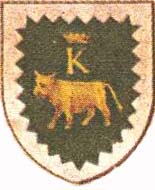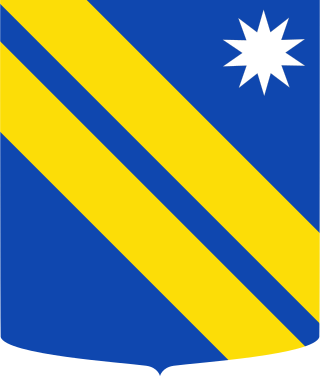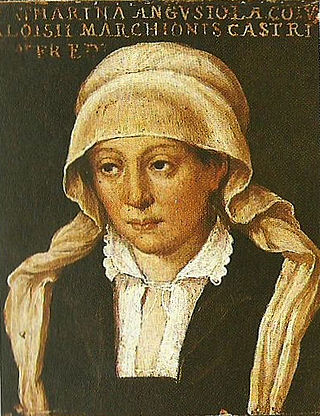
The Collegio Clementino is a palace in Rome, central Italy, sited between the Strada del'Orso and the banks of the Tiber. It was founded by Pope Clement VIII in 1595, to host Slavonian refugees. Giacomo della Porta was commissioned to erect a suitable building to house them, which would be one of the aged architect's last projects. On February 25, 1601, Urban VIII shifted the Slavs to Loreto and refounded the Collegio Clementino as an elite school for young noblemen of every nation and the richest families in Rome. The musical tradition of the Collegio Clementino remained strong: Alessandro Scarlatti wrote oratorios for Carnival seasons and came up from Naples to oversee their production.
The Galluppi are an Italian noble family originally from Tropea and comprising various branches, one of which settled in France in the fourteenth century, another in Sicily around the end of the sixteenth. One of the members of the family named Cristoforo married in 1340 Donna Giacoma Ruffo, baroness of Altavilla, obtaining as a dowry half of the baronial fiefdom of Altavilla.

The House of Bove is an ancient noble patrician family of Ravello, Maritime Republic of Amalfi that held royal appointments in the Kingdom of Naples, and presided over feudal territories. After the dissolution of noble seats of the Kingdom of Naples in 1800 they were ascribed in the Libro d'Oro of Ravello. The Bove coat of arms is prominently displayed in the Duomo of Ravello.

Prince of Belmonte is a noble title created in 1619 by the Spanish crown for the Barons of Badolato and Belmonte. The name of the title is taken from the fortress town of Belmonte in Calabria, historically important for the defence of the Italian coast from Saracen invasion. Belmonte has been known since the Risorgimento as Belmonte Calabro.
Oderisio di Sangro was an Italian Benedictine monk and cardinal, the son of Count Rinaldo of the family of the conti di Sangro in the Marsi.

Duke or Duchess San Donato was a noble title, first created in 1602 by the Spanish King Philip III for the House of Sanseverino. The duchy was traditionally based on estates and territories held in San Donato di Ninea, Calabria. The first creation, however, lasted only 52 years. In 1668, the title was recreated for a wealthy merchant, Antonio Amitrano, who had some years earlier bought the feudal rights over the former dukes' territories. Descendants of the Ametrano family held the duchy, as one several titles, until it became extinct in the 1970s. There have been successive claims over the centuries by distant kinsmen of the first holders to claim the duchy; these remain unverified.

The church of Santi Severino e Sossio and the annexed monastery are located on via Bartolommeo Capasso in Naples, Italy.
Antonio Beccadelli of Bologna (c.1475-1513) was an Italian aristocrat, whose tragic love affair and secret marriage with Giovanna d'Aragona, Duchess of Amalfi, inspired several works of literature, most notably John Webster's The Duchess of Malfi and Lope de Vega's El mayordomo de la Duquesa Amalfi.
Isoletta is a village in Italy, in the Valle Latina within the Arce municipality. Isoletta is located in the province of Frosinone, of the southern Lazio region in Italy.

The Anatomical Machines are a pair of anatomical models reproducing the human circulatory system, displayed in the Cappella Sansevero in Naples. Created in the second half of the 18th century, they are constructed over a male and a female human skeleton. The reproduction of the vessel system is formed of metal wire, wax, and silk, but because of its richness of detail it was for a long time believed to be of natural origin.

The Casa dei Cavalieri di Malta is a historic building in the old town of Bitetto, in the Metropolitan City of Bari, Italy. The building is traditionally associated with the Knights Hospitaller, also known as the Knights of Malta.
Cesina is a toponym of Langobard origin that is used in southern Italy, especially in Campania. It derives from the Latin word caesi and the Latin verb caedere, to which the Langobard suffix -na is added.

The House of Gravina, then Gravina Cruyllas, was a noble family of Norman origins, with roots stretching back to Rollo, the first ruler of Normandy.

Ottavio Serena was an Italian politician, judge, prefect and historian. He is known in his hometown Altamura for his works about local history, such as the Altamuran Revolution (1799). His contribution and the testimonies he collected allowed to shed light on some historical events (such as the killing of Giovanni Firrao and on legendary toponyms.

The Ceva Grimaldi are an Italian noble family established in Southern Italy since the 16th century but whose origins are in Piedmont and Liguria and date back to the 10th century. The main titles associated with this branch of the Ceva family are Marchese di Pietracatella and Duca di Telese.
The Cesina family is an Italian family of Roman-Lombard origin.
Carlo Amalfi or Aniello was an Italian painter, active in the Kingdom of Naples as mainly a portrait artist.
Francesco I Ventimiglia was an Italian nobleman and politician. He inherited the title of Count of Geraci.

Caterina Anguissola Trivulzio was an Italian noblewoman.

Castel Petto, also known as Villa Petto, is an Italian village in the municipality of Colledara, a municipality located in the territory of the Province of Teramo, in the Abruzzo region. It is located 450 meters above sea level, on the slopes of Mount Cicembro. It is 20 km from Teramo, the provincial capital.













